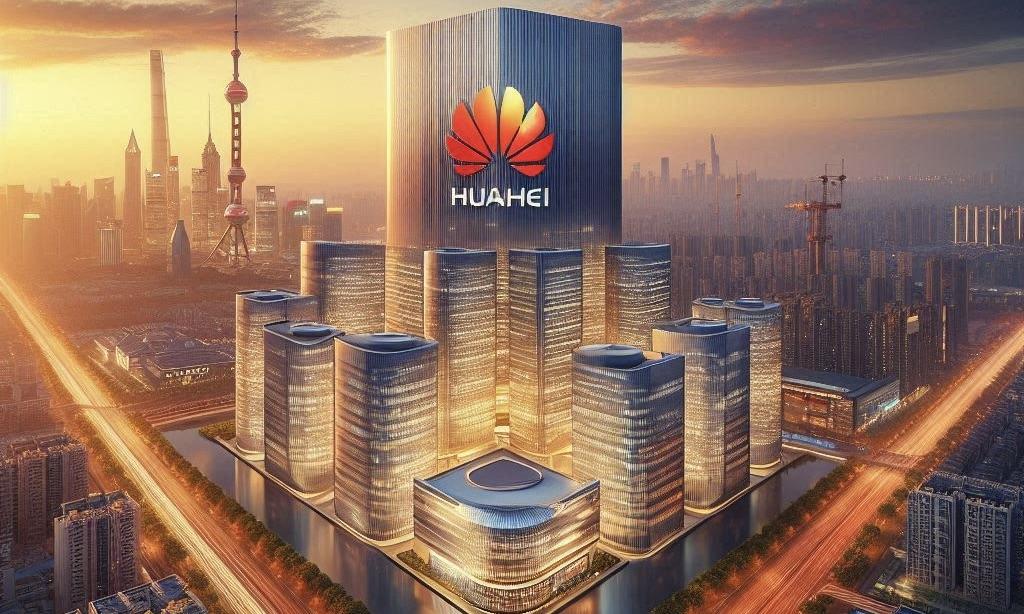Huawei Technologies Co. is nearing completion of a $1.4 billion semiconductor research and development center in Shanghai. The state-of-the-art facility, expected to house 30,000 personnel, will advance China's tech ambitions despite ongoing US efforts to hinder its progress.
Huawei Finalizes $1.4 Billion Shanghai R&D Hub to Propel Semiconductor Innovation
Huawei Technologies Co. is on the brink of completing the construction of a semiconductor research and development center in Shanghai. This development is expected to further China's technological aims despite the United States' efforts to impede its growth.
As detailed on the Shanghai government's website, the new Huawei research and development center in Shanghai is a state-of-the-art facility. It will be Huawei's most significant research center globally, accommodating approximately 30,000 personnel. The site in Qingpu district spans 1.6 million square meters. It is equipped with its road network, a minor railway system, and elevated bridges, demonstrating the center's advanced infrastructure and capabilities.
State media reported in January, citing a Shanghai government briefing, that the new facility would pursue semiconductor advancements for devices, wireless networks, and the Internet of Things. According to a statement published on the Qingpu government website, the total investment cost is 10 billion yuan ($1.4 billion).
Despite US Sanctions, Huawei Advances with New 5G Phone and Semiconductor Developments
Huawei has been subject to US sanctions and export regulations for years as Washington and Beijing compete for dominance in the semiconductor industry. Last year, the company effectively circumvented US restrictions to introduce a new 5G phone with a cutting-edge 7-nanometer chip manufactured in China.
Since then, the Biden administration has implemented additional measures to restrict Huawei's semiconductor development, such as requesting that its allies impose further constraints on China's semiconductor industry. It also revoked licenses that permitted Huawei to purchase specific processors from Qualcomm Inc. and Intel Corp to address any loopholes in the current conditions.
The industry should examine Hualikely Wei's Mate 70, the company's forthcoming flagship smartphone, to see if there is any indication that Beijing has made additional progress in processor development. The Mate 70 is anticipated to be released later this year. The Mate 60, its predecessor, was in high demand among local consumers and assisted Huawei in gaining a portion of the market share at the expense of its competitors, such as Apple Inc.



 Nissan Halts U.S. Orders for Infiniti SUVs Amid Trump Tariffs
Nissan Halts U.S. Orders for Infiniti SUVs Amid Trump Tariffs  China Backs Viral AI Startup Manus Amid Global Buzz and Domestic Rollout
China Backs Viral AI Startup Manus Amid Global Buzz and Domestic Rollout  BYD to Launch 500 Ultra-Fast EV Charging Stations in April, Doubling Tesla’s Speed
BYD to Launch 500 Ultra-Fast EV Charging Stations in April, Doubling Tesla’s Speed  ReliaQuest Secures $500M to Boost AI Cybersecurity, Hits $3.4B Valuation
ReliaQuest Secures $500M to Boost AI Cybersecurity, Hits $3.4B Valuation  Trump to Decide on TikTok Sale as April 5 Ban Deadline Nears
Trump to Decide on TikTok Sale as April 5 Ban Deadline Nears  SK Hynix Sees Chip Order Surge Ahead of Possible U.S. Tariffs, Eyes AI Memory Boom
SK Hynix Sees Chip Order Surge Ahead of Possible U.S. Tariffs, Eyes AI Memory Boom  CoreWeave Slashes IPO Size and Price Amid Investor Caution Despite Nvidia Backing
CoreWeave Slashes IPO Size and Price Amid Investor Caution Despite Nvidia Backing  NLRB Halts Apple Cases Following Trump’s Nomination of Apple-Linked Lawyer
NLRB Halts Apple Cases Following Trump’s Nomination of Apple-Linked Lawyer  Ford Launches Major Discounts Amid Rising Tariffs and Inventory Surge
Ford Launches Major Discounts Amid Rising Tariffs and Inventory Surge  Walmart Pressures Chinese Suppliers to Cut Prices Amid Tariff Impact
Walmart Pressures Chinese Suppliers to Cut Prices Amid Tariff Impact  PayPal to Launch Personalized Ads in the UK Starting July
PayPal to Launch Personalized Ads in the UK Starting July  FuriosaAI Rejects $800M Meta Takeover, Aims to Rival NVIDIA in AI Chip Race
FuriosaAI Rejects $800M Meta Takeover, Aims to Rival NVIDIA in AI Chip Race  Morgan Stanley Eyes ¥100 Billion for Japan Real Estate Fund
Morgan Stanley Eyes ¥100 Billion for Japan Real Estate Fund  Elon Musk Merges xAI with X in $113B Deal to Build AI-Powered Tech Giant
Elon Musk Merges xAI with X in $113B Deal to Build AI-Powered Tech Giant  Former Intel CEO Pat Gelsinger Joins Playground Global to Drive Chip Innovation
Former Intel CEO Pat Gelsinger Joins Playground Global to Drive Chip Innovation  Nintendo Switch 2 Launches June 5 at $449.99 with Major Upgrades
Nintendo Switch 2 Launches June 5 at $449.99 with Major Upgrades 





























